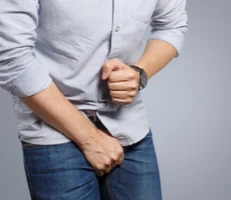There are different types of urinary incontinence, or unintentional loss of urine, in men, including stress incontinence, urge incontinence and overflow incontinence. Some men may have one or a combination of all three.
Functional Incontinence: Occurs due to a physical disability, external obstacles, or cognitive or communication issues that prevent an individual from reaching a place to urinate before accidental leakage. Examples of functional incontinence include a man who cannot walk to a restroom in a timely manner due to arthritis, or an Alzheimer’s patient who may not plan ahead for a trip to a restroom.
Stress Incontinence: Refers to the uncontrollable loss of urine when pressure is exerted on the bladder. Leakage of urine may occur during actions such as coughing, sneezing, and lifting. Stress incontinence in men may occur after prostate surgery, neurologic injury to the brain or spinal cord, or trauma. Men may also become more susceptible to stress incontinence as they age.
Urge Incontinence: Involves the involuntary loss of urine followed by and sudden unstoppable urge to urinate. Common urge incontinence triggers in men include drinking a small amount of water, hearing running water, touching water, or being in a cold setting. In some instances, anxiety, liquids, or medications cause urge incontinence. Additionally, urge incontinence has been linked to stroke, Parkinson’s disease, multiple sclerosis, and other medical conditions that can damage the brain, bladder nerves, spinal cord, or sphincter nerves.
Overflow Incontinence: Characterized by constant dribbling of urine, accompanied by frequent, yet small urination. Overflow incontinence is commonly associated with nerve damage from diabetes or other diseases that weakens the bladder muscles. Additionally, overflow incontinence often occurs from a blockage of urine from an enlarged prostate (BPH).
Transient Incontinence: Refers to UI that lasts only a short period of time. Transient incontinence is associated with certain drugs or medications, and it also has been linked to temporary conditions. For example, excessive caffeine or alcohol consumption may cause the bladder to fill up quickly, or a urinary tract infection may irritate the bladder, resulting in a strong urge to urinate.

You must be logged in to post a comment.